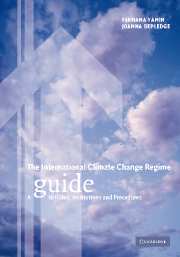Book contents
- Frontmatter
- Contents
- List of figures
- List of tables
- List of boxes
- Foreword by Joke Waller Hunter, Executive Secretary, FCCC
- Preface and acknowledgements
- List of abbreviations
- 1 Introduction
- 2 Overview
- 3 Regime participants
- 4 Objective and principles
- 5 Mitigation commitments
- 6 Flexibility mechanisms
- 7 Research, systematic observation, education, training and public awareness
- 8 Adaptation
- 9 Impacts of response measures
- 10 Finance, technology and capacity-building
- 11 Reporting and review
- 12 Compliance
- 13 Institutions
- 14 The negotiation process
- 15 Scientific and technical input
- 16 Administering the regime
- 17 Linkages
- 18 Evolution of the regime
- 19 Conclusion: taking stock and moving forward
- Appendix I List of Parties, their groups and key statistics
- Appendix II Annex I Party fact sheets: emissions, targets and projections for Annex I Parties and groupings
- Appendix III Table of Articles, issues and COP Decisions
- Bibliography
- Index
18 - Evolution of the regime
Published online by Cambridge University Press: 16 July 2009
- Frontmatter
- Contents
- List of figures
- List of tables
- List of boxes
- Foreword by Joke Waller Hunter, Executive Secretary, FCCC
- Preface and acknowledgements
- List of abbreviations
- 1 Introduction
- 2 Overview
- 3 Regime participants
- 4 Objective and principles
- 5 Mitigation commitments
- 6 Flexibility mechanisms
- 7 Research, systematic observation, education, training and public awareness
- 8 Adaptation
- 9 Impacts of response measures
- 10 Finance, technology and capacity-building
- 11 Reporting and review
- 12 Compliance
- 13 Institutions
- 14 The negotiation process
- 15 Scientific and technical input
- 16 Administering the regime
- 17 Linkages
- 18 Evolution of the regime
- 19 Conclusion: taking stock and moving forward
- Appendix I List of Parties, their groups and key statistics
- Appendix II Annex I Party fact sheets: emissions, targets and projections for Annex I Parties and groupings
- Appendix III Table of Articles, issues and COP Decisions
- Bibliography
- Index
Summary
Introduction
Like most modern MEAs, the Convention and the Protocol are framework agreements that allow the regime's institutions to review and assess commitments in response to changing scientific, technical and legal information and experience with implementation. The main mechanism to foster evolution of the regime is the establishment of a COP and COP/MOP with built-in powers to review and adopt instruments containing new commitments, including legally binding instruments in the form of amendments, annexes and protocols, as well as rules and procedures that define how, and in some cases when, negotiations about commitments may proceed. This chapter explains the review provisions contained in the FCCC and the Kyoto Protocol and the various kinds of legal instruments relevant to the evolution of commitments under the climate regime. The institutional mandate of the COP and structures and techniques deployed in negotiating processes are critical components in understanding how the climate regime will address evolution of commitments and are explained in depth in chapters 13 and 14. Section 2 explains what is meant by commitments, different types of commitments, how they are created under the climate change regime and their resulting legal effect. The review procedures of the Convention and the Protocol are explained in section 3.
The final section explains briefly how developments taking place outside the international negotiations on climate change can have an important impact in framing the discussions on future commitments.
- Type
- Chapter
- Information
- The International Climate Change RegimeA Guide to Rules, Institutions and Procedures, pp. 544 - 559Publisher: Cambridge University PressPrint publication year: 2004



